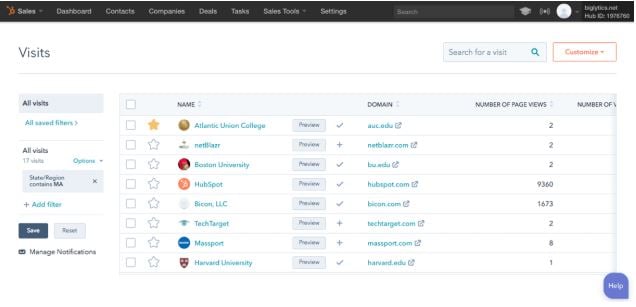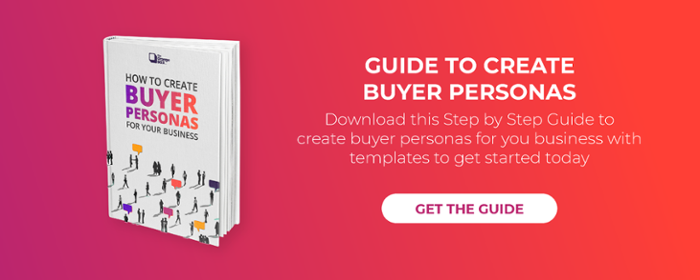Lead Generation
Step-by-Step Guide to Finding your Ideal Buyer Persona

Haydeé Ferrufino
Haydeé Ferrufino | Apr 23, 2018 | 7 MIN READ
Apr 23, 2018 7 MIN READ

Can you imagine a world where you would only need to open the door of your business or launch your new website so a wild hard of people call you and purchase your service or product without saying a thing? Well, I sure couldn’t! But here’s the deal…
Since Inbound Marketing emerged, more and more B2B companies have experienced a quite similar feeling by applying lead generation best practices.
The truth is you might be struggling to grow your company or wonder why is it that you have lots of prospects arriving but not actually purchasing your product or service.
With this article you’ll learn why is important to have a clear view of your ideal client, the benefits of applying technique to your company and how to create your first ideal consumer profile to grow your business.
- Define who you are
- Pick who you’ll like to do business with
- Conduct interviews to only your best clients
- Wrap up and create your ideal buyer persona profile
- Bonus tip: use the magic of data!
Developing your Ideal Customer Profile in 4 Simple Steps
Unlike what you might have think when you first started reading this article, we can’t start “assuming” who your Buyer Persona most look like or who your client should be. To lie a strong foundation you have to thinking from the inside out as detailed in the 4 easy following steps:
1. Define Who you Are

This step might sound simple, but most of our client struggle identifying exactly what makes them unique. We help our clients overcome this process from the get-go, to make sure you work their content strategy around what makes them unique, to help them stand out.
You’ll need to bring on board your marketing and sales manager if you are a VP or CEO or the other way around. You need to make sure you can brainstorm with your team what makes you really unique and review your current positioning to make sure you are being clear enough explaining who you are and why you do what you do.
2. Pick Who you’ll Like to do Business With

Your ideal client profile should be based on well done research and interviews to your current Buyer Personas to gather the information you’ll be to get this project going.
To make sure we only get the best fruits on the tree you’ll have to separate good clients from bad clients, this will help you create both: Ideal Buyer Persona Profiles and Negative Buyer Persona Profiles.
Both type of profiles are helpful to assist your sales team on who to pay attention to and who to disregard in order for them to save time and effort only in the high-quality prospects.
To identify your good Buyer Persona you’ll want to make yourself the following questions:
- Which are your most profitable accounts?
- Which clients signed on with your company within or below the normal sales cycle range?
- Do you enjoy working with these clients?
- Does the client pay within your acceptable collection period?
- Is the work fulfilling?
- Does the client provide positive and constructive feedback?
- Did the client provide any referral to your company or publicly provided a great testimonial of your product or service?
- Does the client engage with your brand beyond expected?
- Have the client experienced great results with the services or products provided by your company?
3. Conduct Interviews with only your Best Clients

Once you have the best clients separated from the bad ones, make sure to create an easy to understand and detailed interview, make sure you make the interview about them, not about your product or service and please don’t make this a “Buyer Persona satisfaction survey” we are looking for the nitty-gritty of what drives them and how to connect with them or you can also download our free guide with useful templates to get started today.
Here are some great questions you should include:
Information About the Decision Maker
- What is your role?
- How long have you been at the company?
- How long were you employed at your previous role?
- What skills are required to do your job?
- What tools do you use in your job?
- Who do you report to? Who reports to you?
- What does a typical day look like?
- What people in your company make decisions about selecting a product or vendor?
Their Company Insights
- In which industry or industries does your company work?
- What is the size of your company (revenue, number of employees)?
- What is your company’s marketing, sales or operational budget per year? (depending on your product or service)
- What percentage of this is used on agencies, vendors and additional outside sources?
- What does your sales cycle look like?
About Goals & Challenges
- What’s your Job position?
- What are your job responsibilities and priorities?
- How is your job measured and how often?
- Who do you report to?
- What does it mean to be successful in your role within the company?
- What are your biggest challenges?
Information on their Research Process
- What sites and magazines or other publications do you frequently visit to learn new information for your job?
- What associations or groups do you belong to?
- What conferences do you attend?
- What social networks do you use and how do you use them?
- How do you begin the search for a new provider?
- Do you search for a company on Google, Bing or what search engine? If so, what keywords do you use?
Your prospect’s Identifiers
- How do you normally handle conflict?
- Do you like to work independently or in a group?
- What’s your preferred style of communication?
Their Common Objections
- Why is it difficult to work with a provider?
- Do you normally bring the work home?
- During the sales process, what points about our company made you hesitant to work with us?
- Where did you turn to find out information about our company from other sources?
Purchasing Decisions
- Why did you decided to work with our company?
- Why have you stayed with us for X years or period of time?
- What did the decision process look like for you or your team?
- How are we unique from other vendors you have worked with?
- What are three important qualities you look for in a vendor or service provider?
4. Wrap up and Create your Ideal Buyer Persona Profile
Now that you finish gathering the necessary date, hop into your computer and review it, taking the common behaviors and answers that you could capture in the interview and create your ideal client profiles.
A profile is not only a chart showcasing the demographics and aspects of the person, it also needs to tell a story of who your ideal Buyer Persona is. For example you can name them as Josh CEO, Sales Amy, James VP or any other name that can stick into your sales team minds and help them remember who this person is and what's the life is living, this will help giving your team a sense of knowing a great new friend and providing support as they would do to their best friends.
Congratulations you made it! Now you are more than ready to start creating your first Ideal Buyer Persona, and as a prize, I’ve prepared a bonus tip and a free guide that’ll help you create a reach ideal buyer persona profile and a much more insightful buyer persona profile.
Bonus Tip: Use the Magic of Data!

Tap into your preferred analytics tool and review the demographics of your website visitors, if you use a sales tool or lead generation tool such as Hubspot Sales or Leadfeeder, you’ll be able to tackle some detailed insights on company name, industry, job position and much more of your current traffic.
Additionally, if you already use LinkedIn pixel or Facebook Pixel for while, you can make a great use of the lookalike audiences and review further new insights about the people that already know your business.
TABLE OF CONTENTS
Stay Updated with Our
Latest Posts
Subscribe now to receive the freshest content, insights, and updates directly in your inbox.




.png?width=90&height=90&name=facebook%20(1).png)
.png?width=94&height=96&name=Vector%20(1).png)
